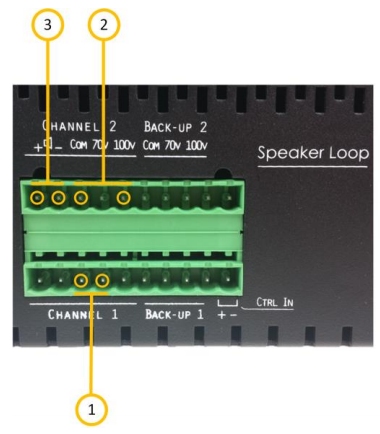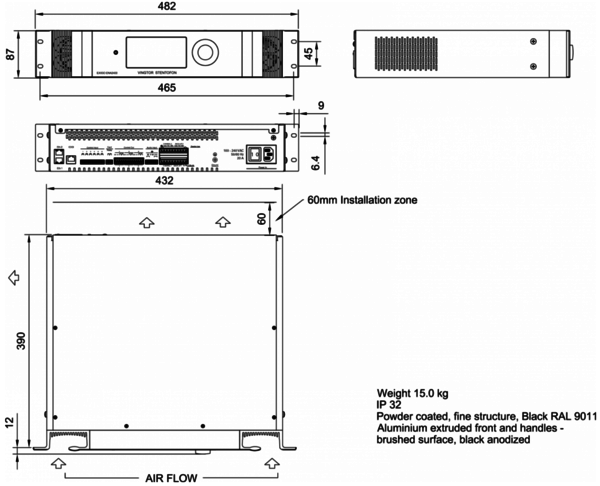Difference between revisions of "ENA2400-AC"
(→Dimensions) |
(→Loudspeaker Connections) |
||
| Line 138: | Line 138: | ||
|} | |} | ||
<br> | <br> | ||
| − | + | The loudspeaker outputs from the amplifier should be routed to terminal blocks in the equipment rack according to system requirements. | |
| − | The | + | == Backup Amplifier == |
| + | The [[ENA2200]]/[[ENA2400-DC]]/ENA2400-AC supports backup amplifiers, meaning that one amplifier can act as backup for up to 6 other amplifiers. <br> | ||
| + | The backup amplifier will take over the output of the first faulty amplifier to maintain system integrity based on the configuration. <br> | ||
| + | See '''[[Backup Amplifier| this section]]''' for more details. | ||
== Dimensions == | == Dimensions == | ||
Revision as of 11:49, 4 May 2018
Exigo Network Amplifier
- 2x 400 watt continuous GA effect
- 2x 400 watt PA effect
- Power efficient class D technology
- Powered by 110 - 230 VAC
- Redundant Ethernet connections
- Digital audio processing, equalizer and audio delay
- Loudspeaker line monitoring
- Input for backup amplifier
The Exigo Network Amplifier is designed for use in marine, offshore and other demanding environments.
The amplifier utilizes state-of-the-art class D amplifier technology to ensure high power efficiency and superb audio quality.
The Exigo Network Amplifier is part of the Exigo PA/GA system, which is based on standard Ethernet network and digital processing.
Each amplifier has two network connections, allowing for redundant cabling between the amplifier and the network.
Using standard network equipment also allows for a much wider selection of standard network equipment.
The complete amplifier is self-monitoring and this includes advanced monitoring of the speaker lines and internal system.
The audio output channels can be monitored for line faults such as shorts, ground faults and large load changes. In addition, up to 10 intelligent Line End Transponders (ELTSI) can be placed on the speaker lines for additional accuracy in the line monitoring.
The amplifier also monitors control inputs, power supplies, temperature, network connections and every other components required for operation of essential services.
Faults will be reported to the system controller, but will also be indicated locally on the amplifier.
The amplifier operates from a 115/230 VAC supply and is designed to survive minor interruptions to the power supply.
The amplifier’s configurable control inputs/outputs and audio inputs can be used locally by the amplifier (e.g. for PTT and audio from a handheld microphone) or can be controlled by the system (e.g. audio input for background music).
Installation
Overview - Front
| 1 | Mounting Flange | The mounting flanges are used to mount the unit in 19” equipment racks |
| 2 | Ventilation Inlets | The ventilation inlets should be kept free of obstacles and dust. Fans control the airflow based on internal temperature |
| 3 | Headphone Jack | The headphone connection can be used to listen to the different audio streams in the Amplifier. |
| 4 | Status Indicators | The status indicators are used to display the status of important parameters such as power supplies and faults |
| 5 | LCD Display | The LCD screen displays status and a graphical user interface |
| 6 | Control Knob | The control knob is used to select and execute menu items in the user interface. The knob can be rotated and pressed. |
| 7 | Integrated Handle | These integrated handles make it easy to maneuver the unit, without adding to the installation depth |
| 8 | Ventilation Inlets | The ventilation inlets should be kept free of obstacles and dust. Fans control the airflow based on internal temperature |
Overview - Back
| 1 | Ethernet Ports | Redundant Ethernet connections for audio and control data |
| 2 | Serial Console | Serial port connection for debugging and factory programming |
| 3 | Control Inputs | 6 configurable control inputs. Each input is activated by closing the loop between the two terminals |
| 4 | Fault Relay Output | A switching relay (NO, NC & COM) kept in the active position between COM and NO as long as no faults are present in the device |
| 5 | Control Outputs | Six configurable control outputs. Each is made of a switching relay (NO, NC and COM) in parallel with a 24VDC signal. The 24VDC part of the control output can source max 200mA and has overcurrent protection |
| 6 | Audio Inputs | Microphone and line-in audio inputs for microphones or external audio sources |
| 7 | Speaker Outputs | 100 and 70 volt outputs per channel. Each channel also has a low-power 8ohm output for single speakers. Each channel is equipped with inputs for connection to a hot-standby amplifier |
| 8 | Ground Connection | Ground connection for grounding of the unit. This is connected in parallel with the ground connection in the AC power inlet |
| 9 | AC Power Switch | Power switch for AC power |
| 10 | AC Power Inlet | AC power inlet for 110 to 230 VAC. The power inlet has a V-Lock mechanism for a secure connection |
Placement and Stacking
The amplifier is designed to deliver full power at ambient temperatures up to 55 °C. As long as the equipment rack is well ventilated, amplifiers can be stacked with no extra space between them. It is however recommended to add 1 HU between every group of 4 amplifiers.
Mounting
The amplifier’s mechanical construction is rigid enough to be mounted using only the four holes in the mounting flange to secure it to the rack. It is however considered good practice to mount support rails if the system is installed in a mobile environment.
Power Supply
The Amplifier shall be connected to the equipment rack’s primary and secondary (emergency) source of power.
Only one power source may be connected if the power source itself is redundant (e.g. UPS) or if the class/installation permits a single source of power
DC power input are equipped with a lock, preventing the plug from falling out. Make sure that the plug is properly inserted, and that the lock is engaged
The requirements for the power rails are listed in the Technical Specifications for the amplifier. The cables used for the power shall be dimensioned accordingly to the voltage and current consumption of the amplifier.
Grounding
It is always good practice to ground the cabinet of equipment installed in racks. This ensures safety and good EMC. If the unit is powered entirely through the DC power inlet, the ground connection is the only way to connect the Amplifier to ground. The ground connection of the Amplifier should be connected to the equipment rack’s ground strip using a ground wire of at least 0.75 mm² (AWG 19).
If the Amplifier isn’t connected to ground, it will not be able to detect ground faults or short-circuits to ground
Ethernet Connections
The Amplifier shall be connected to the network using one or two Ethernet cables, depending on the system interconnection scheme.
Fault Relay
The Amplifier’s fault relay will trigger whenever a fault occurs in the amplifier. This relay is actively kept closed by the Amplifier so it will trigger even if the entire amplifier loses power. The connection to external equipment should be made according to the external equipment’s requirements. When no faults are present in the amplifier, an electrical connection is established between the COM and NO terminals of the fault relay. When a fault is detected, or the amplifier loses power, this connection is removed and a connection between COM and NC is established.
The fault relay should be routed from the Amplifier output to a terminal block in the equipment rack if required by the specific system.
The fault relay on the system controller will trigger in parallel with that of the amplifier. In most cases, it is sufficient to use only the fault relay on the system controller.
Control Inputs
The Control Inputs should be routed from the Amplifier screw terminal to terminal blocks in the equipment rack.
Control Outputs
The Control Outputs on the Amplifier should be routed to terminal blocks in accordance with the specific system’s requirements. Cable diameter used is max 1 mm2 flexible.
Audio Inputs
The two audio inputs on the Amplifier can be used for background music, external alarms or local microphone. The audio inputs should be routed to terminal blocks in the equipment rack or local audio sources.
Loudspeaker Connections
The Amplifier has three different options for loudspeaker connections: 8Ω, 70 volts and 100 volts. The 8Ω output is only intended for local monitoring of audio, and the power is therefore limited compared to the 70 and 100 volt lines.
| 1 | 70 volt connection |
| 2 | 100 volt connection |
| 3 | 8Ω connection |
The loudspeaker outputs from the amplifier should be routed to terminal blocks in the equipment rack according to system requirements.
Backup Amplifier
The ENA2200/ENA2400-DC/ENA2400-AC supports backup amplifiers, meaning that one amplifier can act as backup for up to 6 other amplifiers.
The backup amplifier will take over the output of the first faulty amplifier to maintain system integrity based on the configuration.
See this section for more details.
Dimensions
Accessories

|

|
|---|---|
| ELTSI-1 | EAM-400 |
Additional Documentation
For more documentation, please visit the Zenitel web page: https://www.zenitel.com/product/ena2400-ac




